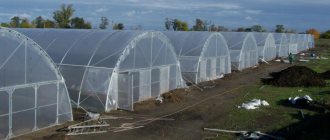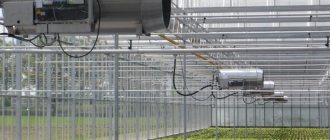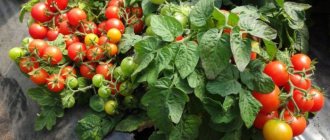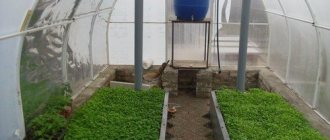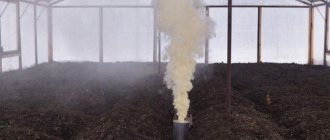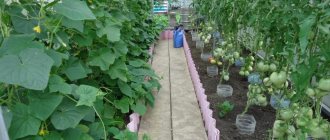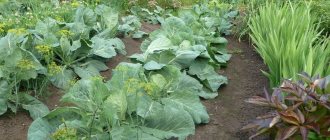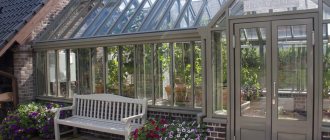Why mulch the soil?
Mulching has many benefits , it reduces the evaporation of water from the soil surface, protects plants from frost, improves soil quality, promotes the development of life in the soil, reduces the number of weeds, and coarse mulch even repels slugs.
Mulch is also used as a decorative element in the garden or vegetable garden.
In addition, we need to consider one thing that we are not used to thinking about.
When we grow plants in the soil, the soil gives nutrients to the plant and its fruits.
But are we returning these nutrients back to the soil so that we can get a useful and healthy harvest in the new season?
Mulching is one way to replenish nutrients in the soil.
The soil retains moisture longer
Water evaporation from soil covered with mulch occurs three times slower than from bare soil.
This allows you to save water and time that you would otherwise spend on watering.
Prevents soil from being washed away
A 10 cm layer of mulch, especially on slopes, helps prevent the leaching of nutrients from the soil.
Keeps weeds from growing
Mulch does not transmit light to the soil surface, which prevents the germination and growth of weeds.
Prevents the appearance of crust on the soil surface
Mulching protects the soil from compaction, from the formation of a dense crust, as a result of exposure to the force of rain.
This crust prevents water from penetrating into the soil the next time it rains or waters.
Supports and develops life in the soil
Organic mulch serves as a refuge for beneficial insects, microorganisms, and earthworms.
Increases soil fertility
Over time, organic mulch decomposes and becomes part of the soil, turning into humus, which increases soil fertility and allows earthworms to colonize it.
Vegetables will remain clean
Mulch acts as a layer between the soil and fruits, especially fruits that hang directly onto the soil.
Due to this, the fruits do not come into contact with the soil and remain clean.
Maintains soil temperature
When the soil is covered with organic mulch for the winter, it protects the roots, crown and stems of winter crops from extremely low temperatures.
In summer, on the contrary, organic mulch prevents the soil from heating up too much.
Inorganic mulch has a different effect: soil covered with black plastic warms up faster in early spring, allowing plants to be planted earlier.
What to do if the soil on the site is damp?
In wet and swampy areas, when there is water between the rows, such mulching is not suitable, since water prevents air from entering the grass. The water does not evaporate, and the mulch will simply rot. And the roots will rot in water even without mulch.
But there is a way out. Make high beds, fence them with boards, raise them to a height of 60 cm. The area will be the same, but the top of the beds will not be in the water. And it is not only possible, but also necessary to mulch such beds.
Types of mulch
Organic mulch
Organic mulch refers to decomposed materials that will become part of the soil in the future.
Organic mulch includes:
- straw
- pine chips
- wood chips
- bark of tree
- grass clippings without seeds
- leaves
- pine needles
- seaweed
- hemp
- compost
- cardboard
- newsprint
- sawdust
- fern
- buckwheat husk
- coconut mulch
- sackcloth
Mineral mulch
Mineral mulch is not biodegradable, making it last forever.
This type of mulch is recommended for heat-loving plants.
One of the most popular mineral materials is pozzolan - a dusty product, a mixture of volcanic ash, pumice and tuff.
This material has a porous structure and has good thermal insulation properties.
Mineral mulch includes:
- pozzolan
- gravel
- pebbles
- sand
- expanded clay
- broken brick
- pieces of slate
Inorganic mulch
This group includes polyethylene, agrofibre and textile material.
If you use a drip irrigation system, then first, you need to install it and spread mulch on top.
Mistake #6: incorrect mulch composition
Various materials are used for mulching: from mowed lawn grass to crushed bark or crushed stone. Some types of mulch are better for some plants, but may harm others. Thus, blueberries, rhododendrons, and hydrangea grow better in acidic soil, so mulch made from pine needles and pine bark is suitable for them. But you should refrain from using such a coating for other crops, because... high acidity of the soil will have a bad effect on their development.
Grapes and strawberries, for example, respond well to mulching with straw, leaves, grass clippings and compost. Shredded wood chips are not the best cover for green crops, because... may cause them to wither.
Therefore, when choosing material for mulching, take into account the characteristics of each crop. Lawn grass is considered a universal mulch.
- What mulch to use for different crops
The productivity and beauty of flowering plants often depend on what they are mulched with.
Mulching materials
The thicker and stronger the material, the longer it will take to decompose.
Straw as mulch
Straw is rich in potassium.
It is advisable to use organic straw to avoid bringing pesticides onto your property.
Ideal for sandy soils and slopes, prevents soil erosion.
Straw allows air, water and prevents weed growth, but contains few nutrients.
Cut grass
A short-lived type of mulch, its service life is only a few months.
It retains moisture well in the soil and is rich in nitrogen and nutrients.
For mulch, you need to mow exactly the grass that does not contain weeds.
Before using grass as mulch, it must be dried in the sun to avoid mold and mildew.
The layer of grass on the soil should not be too thick to avoid rotting.
If the grass clippings are small in size, this mulch is convenient to use for leafy vegetables, as well as cucumbers, zucchini, pumpkins and potatoes.
Autumn leaves
Used for plants that are sensitive to frost, such as: dahlias, gladioli, agapanthus, parsnips, carrots, tuberous parsley, turnips, radishes, beets, celery, Jerusalem artichokes.
Polyethylene
Black polyethylene enhances solar heat, creating a microclimate underneath.
Black polyethylene is often used for grapes, strawberries, melons and cucumbers; it protects them from rotting and keeps the fruits clean.
Polyethylene also prevents the growth of weeds and retains moisture in the soil.
Polyethylene is used in the following way: the surface of the soil is covered with polyethylene and it is well fixed, after which you need to make holes in it into which seeds or seedlings are planted.
With this mulching, it is convenient to use a drip irrigation system, since watering from above through the holes is completely inconvenient.
It is not recommended to use plastic for bushes.
But plastic has significant disadvantages:
- All plastic is toxic, especially when heated by the sun. The poisons that are released from plastic penetrate your plants, that is, your future food, and then into your body.
- water and air cannot penetrate through the plastic, small roots begin to suffer from a lack of oxygen and moisture, as well as from heat and cold, and, in the end, the plants die.
Hemp
Suitable for heat-loving plants.
Ideal for strawberries, tomatoes, zucchini, eggplants and root vegetables.
Hemp mulch is also suitable for protecting spring-mounted bulbs.
Prevents the penetration of slugs, which find it difficult to move around hemp.
Buckwheat husk
Well suited for beds with perennial plants.
Prevents snails and slugs from entering.
Coconut mulch
Coconut mulch has a neutral pH and has the ability to retain water well.
Prevents weed growth.
Used for vegetables, perennials, bulbs and shrubs.
wood chips
The advantage of wood chips is that it does not decompose for a long time.
It is advisable to use on fertile soils as this type of mulch contains very few nutrients.
Well suited for perennial plants.
Pine chips
Pine chips are used for plants that like acidic soils, such as rhododendrons, azaleas or heathers.
Bark of tree
The composition of wood and tree bark is different.
The bark contains more nitrogen, and the wood contains carbon.
Tree bark is used not only as decorative mulch, but also provides benefits.
It retains moisture in the soil, prevents weed growth, keeps weed seeds from penetrating the soil, and regulates temperature.
Pozzolan
Pozzolan is used for mountain plants such as anemone, arnica.
Newspaper or Cardboard
Good at preventing weed growth.
Expanded clay
Suitable for any plants, does not affect soil acidity.
Sawdust
Before using sawdust as mulch, it must rest and rot for 1-2 years so that the sawdust does not burn the plants.
Mistake No. 3: mulching seedlings and low-growing seedlings
Mulching is known to inhibit weed growth. Therefore, some gardeners, in order to avoid unpleasant weeding, rush to cover seedlings that have just been transplanted into the ground or emerging shoots with mulch.
Such “protection” from weeds has a depressing effect not only on them, but also on recently planted crops, because covers them from light. Therefore, it is better to wait until the seedlings and seedlings get stronger and grow (by 5-10 cm), and then mulch them.
When to mulch the soil?
To understand when to cover the soil with mulch, let's look at the natural processes that occur in nature.
Nature covers the soil in the fall and thus prevents it from remaining “naked” in winter, so to speak, nature dresses the soil in winter clothes.
But if we look even more closely, we will see that in fact, the soil is covered with plant material all year round.
Therefore, the answer to this question will be: mulch all year round, your task is to ensure that the soil is always covered and does not remain “bare”.
In spring, you need to mulch when the soil has already warmed up.
There is no need to mulch plants that are afraid of moisture, such as garlic and onions.
Mistake #8: Overwatering
Mulch is intended, among other things, to retain moisture, the evaporation of which occurs more slowly under its layer. Therefore, you should not be overzealous with watering mulched plants. Excess moisture slows down their growth or leads to rotting. If you allow waterlogging, the mulch layer needs to be removed.
Those gardeners who first mulch the planted seedlings and then water them also make a mistake. The sequence of actions must be reversed, otherwise young plants can quickly get sick and die.
How to mulch?
- Before covering the soil with mulch, it must be weeded very well.
- Mulch should not be adjacent to the stem or trunk of the plant.
- Do not mulch in strong winds.
- You cannot mulch frozen soil; you need to wait until it warms up.
- The soil must be watered before and after mulching.
- The minimum layer of mulch should be 5-8 cm. With the exception of some materials.
- In the shade, the layer of mulch should be less than in a sunny place. In the shade, a 3-5 centimeter layer will be enough, and in the sun, 5-8 cm.
- Add 2-3 cm of mulch each year to compensate for decomposed material.
- From time to time you need to ensure that the mulch does not clump.
Mistake #2: Leaving last year's mulch
In the spring, last year's mulch, which protected the plants in winter, should be replaced with a new one, even if it has not completely rotted. After all, pests and pathogens of all kinds of fungal and viral diseases could have settled in such covering material during this time. Therefore, the garden or flowerbed must be freed from the old covering, and the remains of the previous mulch must be burned.
It is also necessary to remove old mulch because it interferes with the heating of the soil. When the danger of frost disappears, you should also get rid of it on bulbous plants (narcissus, tulips, crocuses, etc.). Indeed, under a layer of mulch, their young shoots will not have enough sun, which is why they can grow pale and frail.
In spring, perennial plants also need to be freed from their shelter so that they do not rot under it.
How to mulch fruit trees?
Bacteria that live in the soil are important for the roots of fruit trees.
For trees, the size of the ring, which consists of mulch, is important, the ring should be 50-80 cm from the trunk, since most of the roots are in this area and it is very important to preserve bacterial life in the soil in this area.
Please note that the mulch does not need to be placed close to the trunk, so as not to cause rotting, move 10-15 cm away from the trunk.
It is also very important to choose the appropriate material for mulch, of course, the most suitable material for trees is leaves, this is the material that nature intended.
Also a natural material for trees are branches, which can be chopped to make the mulch look more aesthetically pleasing.
Pine bark is also often used to mulch trees.
These materials are rich in nutrients and will be beneficial for the tree, the most nutrients are found in the leaves, about 50-80% of the total.
The thickness of the mulch layer should not be more than 10-15 cm.
How to make hot herb?
It's very easy to do. First you need to mow and chop the grass. Freshly cut, it is not immediately laid out in the beds, but left in a stack, a pile, or left in a cart for several days. Depending on how long it sits there, fermentation will proceed differently.
In the middle of the herbal mass, the greens acquire a yellow color and a pleasant smell of fermented tea. The closer to the ground, the faster the process occurs. The grass takes on a look and smell reminiscent of manure. It is this kind of grass that is laid out under the plants in the form of mulch.
How to mulch strawberries?
Strawberries are mulched twice a year.
The first time strawberries are mulched in the spring, they are distributed around the leaves, no more than 3 cm thick.
The second time, strawberries are covered with mulch for the winter to protect the plant roots from low temperatures.
It is necessary to mulch for the winter when the soil temperature is about 4 degrees, so that the strawberries can experience the first frost for greater yield.
For strawberries, straw is usually used as mulch.
Mistake #10: Using Weeds Incorrectly
One of the most accessible materials for mulching is weeded weeds. By overheating, they fertilize the soil with useful organic substances. But if you make mistakes when using them, you may not see the harvest.
You can mulch only with weeds that have not yet bloomed. Otherwise, their seeds will scatter and germinate. They also need to be well dried beforehand and the roots must be removed so that they cannot “catch” on the damp soil.
Mulching makes a gardener's life much easier. But in any matter moderation is good. Therefore, you should not cover all free space with mulch; you need to leave open soil for beneficial insects that pollinate plants. You should also avoid using one type of mulch. It will be more useful to alternate different materials.
How to mulch potatoes?
You can mulch potatoes immediately after planting or wait until the soil warms up.
The mulch layer should be about 8 cm thick.
Any biodegradable material is suitable for potatoes, but straw is most often used for this purpose.
Straw is an obstacle to Colorado beetles and other insects.
From time to time it is necessary to check the condition of the mulch and add it to those places where the layer has become thin.
Benefits of hot grass mulching
- Release of carbon dioxide, which is necessary for plant photosynthesis;
- During fermentation, Bacillus hay reproduces well in the grass. And this is ready-made phytosporin, which is bought in stores to improve soil health;
- In the process, the mulch decreases in volume by 2-3 times, forming nutritious organic matter in the lower layer;
- Limiting weed growth, reducing moisture evaporation;
- Plants do not suffer from late blight;
- During the fermentation process, heat is released. This fact helps preserve plants during the return of spring frosts and subsequently makes them healthier. Watch the video to see the results of using hot grass after frost.
The hot grass mulching method is suitable for tomatoes, peppers, eggplants and other vegetables in a greenhouse.
And in open ground, for example, potatoes, zucchini, pumpkin, judging by the reviews, can also be mulched. I hope that you are also interested in this method. I wish you good harvests!


